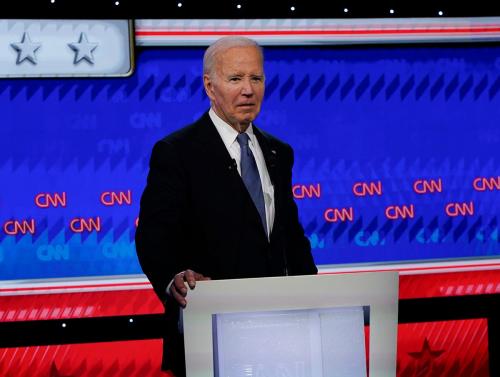It is too early to say how much lasting damage the June 27 debate inflicted on President Biden. But one thing is certain: unless he narrows the gap between where he stood four years ago and where he stands now, he will lose the election.
Let’s begin with the national numbers. Four years ago, on July 9, 2020, Biden led then-president Donald Trump by an average of 9.6 percent points in public opinion surveys. Today, Biden trails Trump by an average of 2.3 points. Put simply, Biden is running nearly 12 points worse nationally than he did at this time in 2020.
The picture in the key swing states is much the same. Four years ago, Biden led Trump in all seven swing states, and he went on to win six of them in November. Today, he trails in all seven, narrowly in some, substantially in others.
Shifts of this size are unusual. Can we take them at face value? After all, the surveys conducted in July four years ago placed Biden far ahead of his eventual performance in November, both nationally and in the swing states. This happened in part because Trump gained ground later in the campaign. In addition, the polls turned out to have a systemic bias. The final preelection polls according to FiveThirtyEight showed Biden leading by 8.4 points or, using RealClearPolitics a different aggregation method, by 7.2 points. His final margin of victory was a substantially smaller, 4.5 points. Both averages came very close to forecasting Biden’s eventual share of the popular vote, but both undershot Trump’s share by about 3 points.
If this bias persists, Trump’s actual lead over Biden could be even larger than it appears. But it is possible that after overestimating Trump’s support in both 2016 and 2020, pollsters have over-corrected, exaggerating Trump’s current lead. We will not know until after the election.
We can say with confidence, however, that Biden’s standing versus Trump is significantly weaker than it was four years ago. In 2020, Biden started with a lead that he never relinquished. This time, he is running from behind, an unusual position for an incumbent president, and catching up will depend on sustaining upward momentum that he has not been able to generate since his politically costly withdrawal from Afghanistan almost three years ago.
The Brookings Institution is committed to quality, independence, and impact.
We are supported by a diverse array of funders. In line with our values and policies, each Brookings publication represents the sole views of its author(s).








Commentary
President Biden lags far behind where he stood four years ago—Can he narrow the gap?
July 10, 2024